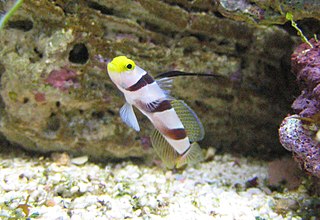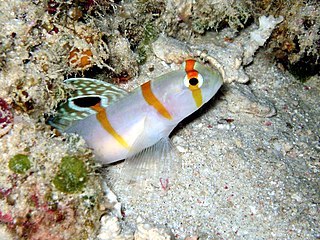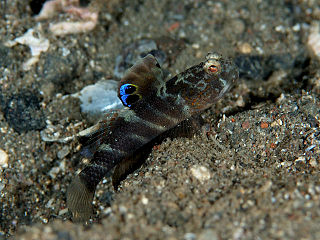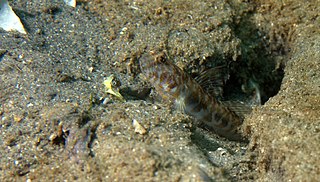
Gobiidae or gobies is a family of bony fish in the order Gobiiformes, one of the largest fish families comprising more than 2,000 species in more than 200 genera. Most of gobiid fish are relatively small, typically less than 10 cm (3.9 in) in length, and the family includes some of the smallest vertebrates in the world, such as Trimmatom nanus and Pandaka pygmaea, Trimmatom nanus are under 1 cm long when fully grown, then Pandaka pygmaea standard length are 9 mm (0.35 in), maximum known standard length are 11 mm (0.43 in). Some large gobies can reach over 30 cm (0.98 ft) in length, but that is exceptional. Generally, they are benthic or bottom-dwellers. Although few are important as food fish for humans, they are of great significance as prey species for other commercially important fish such as cod, haddock, sea bass and flatfish. Several gobiids are also of interest as aquarium fish, such as the dartfish of the genus Ptereleotris. Phylogenetic relationships of gobiids have been studied using molecular data.

The tiger pistol shrimp belongs to the Alpheidae family, known commonly as snapping shrimp.

Stonogobiops nematodes, the Filament-finned prawn-goby, the Antenna goby, the high-fin goby, the red-banded goby, the high-fin red-banded goby, the striped goby, the barber-pole goby, or the black-ray Goby, is a species of marine goby native to the Indian Ocean and western Pacific Ocean from the Seychelles to the Philippines and Bali.

The yellow clown goby, Gobiodon okinawae, also known as the Okinawa goby or yellow coral goby, is a member of the goby family native to the western Pacific from southern Japan to the southern reaches of the Great Barrier Reef. As the name implies, they are bright yellow in color, save for a whitish patch on each cheek.

Nemateleotris magnifica, known by a variety of common names including fire goby, magnificent fire fish, fire dartfish, or red fire goby, is a species of dartfish native to coral reefs of the Indian and Pacific oceans.

Amblyeleotris is a genus of fish in the family Gobiidae found throughout the Indo-Pacific region. This is the largest genus of the shrimp gobies or prawn gobies, so-called because of their symbiotic relationship with certain alpheid shrimps. The shrimp excavates and maintains a burrow used by both animals while the goby, which has far superior eyesight, acts as a lookout for predators. The shrimp maintains almost constant contact with the fish with an antenna. Fossil Amblyeleotris otoliths have been found together with alpheid shrimp remnants from as early as late early Miocene (Burdigalian) suggesting a possible mutualistic association since then.

Amblyeleotris rubrimarginata is a species of goby found on reefs or in sea grass beds in the western Pacific from New Caledonia to the Great Barrier Reef and around New Guinea, Indonesia, Malaysia and the Philippines. It can be found at depths of from 3 to 26 metres. As with other Amblyeleotris species, it has a symbiotic relationship with alpheid shrimps, one or a pair of gobies sharing a burrow with a pair of shrimps.
Amblyeleotris marquesas is a species of goby only recorded from reefs around Nuku Hiva in the Marquesas Islands, French Polynesia in the central Pacific Ocean at depths of 20 to 25 metres. As with other species of their genus, this species has a symbiotic relationship with alpheid shrimps, in this case Alpheus randalli, one or a pair of gobies sharing a burrow with one or a pair of shrimps.

Amblyeleotris steinitzi, Steinitz' prawn goby or simply Steinitz' goby, is a species of small fish in the family Gobiidae. It lives in association with an alpheid shrimp and is found from the Red Sea through the Indian Ocean to the western Pacific Ocean.

The Gobiiformes are an order of fish that includes the gobies and their relatives. The order, which was previously considered a suborder of Perciformes, is made up of about 2,211 species that are divided between seven families. Phylogenetic relationships of the Gobiiformes have been elucidated using molecular data. Gobiiforms are primarily small species that live in marine water, but roughly 10% of these species inhabit fresh water. This order is composed chiefly of benthic or burrowing species; like many other benthic fishes, most gobiiforms do not have a gas bladder or any other means of controlling their buoyancy in water, so they must spend most of their time on or near the bottom. Gobiiformes means "goby-like".

Ptereleotris hanae, commonly known as the blue gudgeon dartfish or blue hana goby, is a species of dartfish native to the western Pacific Ocean. It is a reef inhabitant, being found at depths of from 3 to 50 metres, though usually no shallower than 6 metres (20 ft). It inhabits burrows made by alpheid shrimp, but unlike the Amblyeleotris gobies who normally associate with these shrimp, this species has no interactions with their shrimp hosts. This species can reach a length of 12 centimetres (4.7 in) TL. It can also be found in the aquarium trade.

The yellow prawn-goby is a species of goby native to the Western Pacific, where it can be found at depths of from 1 to 25 metres in coastal bays and lagoons. This species is symbiotic with alpheid shrimps. They share burrows with these shrimp. The species can reach a length of 10 centimetres (3.9 in) SL. These fish vary greatly in appearance, ranging from brilliant yellow to gray and even brown forms or combinations of each coloring. This species is often kept in salt water aquariums. The yellow prawn-goby can be kept in aquariums as small as 20 gallons. In the marine hobby they are often partnered with tiger pistol shrimp.

Amblyeleotris randalli, Randall's prawn goby, is a marine benthic species of goby native to tropical reefs of the central Indo-Pacific. This species can also be found in the aquarium trade.

Amblyeleotris wheeleri, the Gorgeous prawn-goby, is a species of goby native to tropical reefs of the Indian Ocean to the western Pacific Ocean. It can be found at depths of from 5 to 40 metres though is usually does not occur deeper than 15 metres (49 ft). It is a commensal with alpheid shrimps, most often being found in association with Alpheus ochrostriatus. This species can reach a length of 10 centimetres (3.9 in) SL. It can also be found in the aquarium trade.

Amblyeleotris diagonalis, the diagonal shrimpgoby, is a species of goby. It is native to the Indian Ocean and the western Pacific Ocean where it can be found on reefs at depths of from 6 to 40 metres. Amblyeleotris diagonalis is commensal with alpheid shrimps.

Amblyeleotris aurora, the pinkbar goby, is a species of goby native to reefs of the western Indian Ocean at depths of from 5 to 40 metres though usually not deeper than 10 metres (33 ft). It is commensal with the shrimp Alpheus randalli. This species can reach a length of 11 centimetres (4.3 in) TL. It can also be found in the aquarium trade.

Alpheus randalli is a species of snapping shrimp in the family Alpheidae. It lives in the Marquesas Islands and parts of the Indian Ocean, including the Seychelles, in association with a goby of the genus Amblyeleotris. The shrimp is transparent or white with prominent red markings.

Mahidolia mystacina, the flagfin prawn goby, flagfin shrimpgoby or smiling goby, is a species of goby native to the Indian Ocean and the Pacific Ocean from Delagoa Bay, Mozambique to the Society Islands and from southern Japan to Samoa and northern Australia. This species occurs in marine and brackish waters, being found in coastal bays, estuaries and reef bases where the bottom is silty or muddy at depths of from 5 to 25 metres. This species is a commensal with a species of alpheid shrimp, using its burrow as its home. This species can reach a length of 8 centimetres (3.1 in) TL. This species can also be found in the aquarium trade. It was first discovered at the mouth of the Chanthaburi River, Amphoe Laem Sing, Chanthaburi Province, Eastern Thailand by H. M. Smith.

The orangespotted goby is a species of goby native to the tropical Atlantic coast from Bermuda and southern Florida through the Caribbean Sea and Gulf of Mexico south to the Caribbean coasts of Venezuela and Colombia, where it prefers silty bottoms around reefs. It is a commensal with an alpheid shrimp. This species grows to a length of 10 centimetres (3.9 in) TL. This species is the only known member of its genus.

Ctenogobiops tangaroai, the silver-spotted shrimp-goby, is a species of bony fish of the family Gobiidae, native to the reefs which is widespread in the Indo-West Pacific, from the Red Sea and Western Indian Ocean through northern Australia and Taiwan, southern Japan and Fiji. It occurs in fine-grained sand patches at depths of from 4 to 40 metres where it is commensal with alpheid shrimps, with a fish and shrimp sharing a burrow. This species can reach a length of 6 centimetres (2.4 in) TL. It can also be found in the aquarium trade. It is pale in colour marked with four rows of brown spots or dashes along its flanks, three diagonal rows of short, dark stripes on the posterior of its head with larger dark spots on the lower flanks which are frequently surrounded by smaller blue spots and there is a small white stripe above the pectoral fin base with a longer white streak on the pectoral fin. It is the type species of the genus Ctenogobiops.


















